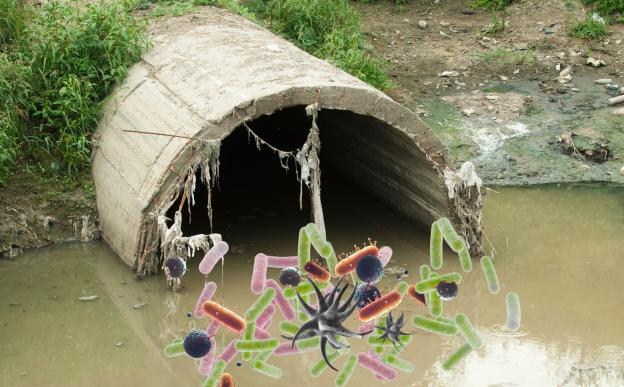Photo: Siddharth Kankaria / Research Matters
If you just relished a cup of yogurt or a platter of cheese, its time to thank the cook – bacteria! Yes, these microorganisms cook up the magic by converting the lactose in milk into lactic acid, thus giving a relishing taste. However, bacteria are often associated with diseases and despair they bring about – think of tuberculosis or ulcers – and are despised. What if, the same bacteria that we despise, are actually helpful in curing yet another serious and often life threatening disease like cancer? Sounds impossible? It is a little known fact that, at least in some cases of bacteria, we have been doing just that for the past 200 years with appropriate reprisals en route!
The first documented evidence of using bacterial therapy against cancer was in 1813, when it was observed that tumours started regressing in a patient suffering from gas gangrene, an infection caused by the bacterium Clostridium. Soon after, William Coley, a physician, came up with reproducible therapeutic efforts in treating patients with sarcomas. He treated cancer patients with a concoction of heat killed Streptococcus pyogenes and Serratia marcescens, known as Coley’s toxin. This discovery opened up a new field, called immunotherapy in cancer, where different strains of bacteria are used to successfully treat cancers like sarcomas, carcinomas, lymphomas, etc.
“In spite of several pre-clinical successes with different bacteria, therapeutic efficacy has not always been translated into human studies”, says Prof. Dipankar Nandi from the Department of Biochemistry and Centre for Infectious Disease Research, Indian Institute of Science, reiterating the distance this path-breaking alternative needs to go. Prof. Nandi and his team have worked on the effectiveness of Mycobacteruim indicus pranii, a harmless bacteria, in the treatment of different types of cancers. Interestingly, Mycobacteruim indicus pranii was first isolated by Prof. Gursaran Pran Talwar from the National Institute of Immunology, New Delhi. The name “indicus” comes from India, “pra” from his middle name and “nii” come from the name of the institute that he founded. Mycobacteruim indicus pranii, after undergoing extensive clinical trials, is approved for use in the treatment of leprosy patients along with chemotherapeutic drugs.
The modus operandi of the bacterial warriors
Conventional cancer therapies such as chemotherapy and radiotherapy are often characterized by the lack of tumour specificity, increased resistance of tumours to drugs, failure to detect metastases and undesirable side effects. Using bacteria, on the other hand, could be a ‘natural’, yet effective way of treatment without these undesired drawbacks.
But how do bacteria fight against tumours? The answer lies in the environment the tumour creates during its growth. A tumour, by definition, is a mass of cells that have divided in an uncontrolled, abnormal manner without respecting the normal boundaries. Bacteria are known to modulate our immune defence system and strengthen it to fight against tumour cells. Bacteria activate our immune systems and provide an environment for the production of T cells, a type of lymphocyte, that displays greater ability to specifically recognize and act against tumour cells.
For example, intra-dermal injection of Mycobacterium indicus prannii induces our immune cells to release chemicals called cytokines that recruit other cells to attack and kill tumour cells. Prof. Nandi’s lab has extensively researched into the mechanisms employed by Mycobacterium indicus pranii bacteria that fight against cancer. “Our research has shown that heat killed Mycobacterium indicus pranii, injected intra-dermally, induces anti-tumour T cells which lowers the growth of tumours”, comments Prof. Nandi.
The warriors in the field
Like MIP, there are a variety of bacterial warriors that work against different type of cancers. Some studies have focused on using Bacillus Calmette Guerin (BCG), a well-known bacterium used to vaccinate against tuberculosis. Often, BCG is the first vaccine received by babies as it is effective against tuberculosis. In fact, the only Food and Drug Administration (FDA) approved bacterial therapy against cancer uses live BCG. “It works as an immune stimulator against non-muscle invasive bladder cancer and is known for its demonstrated superiority over the drug doxorubicin”, explains Prof. Nandi. Although BCG is very effective against bladder cancer, it is known to cause significant immune toxicity.
In the tug of war between safety concerns and effectiveness, Mycobacterium indicus pranni stands out as a non-pathogenic and saprophytic bacterium. Unlike BCG, it can be used after being killed by heat and is still capable of all immunological responses. In some cases or conditions where MIP is not effective, a combination therapy with a drug called cyclophosphamide, has been found to be immensely effective.
Safety concerns and the future roadmap
Would it be safe to deliberately infect a patient with potentially disease causing bacteria? “Safety concerns do exist in cancer treatments”, admits Prof. Nandi. “For example, a major concern for the full exploitation of some bacteria in cancer treatment is their immunogenic properties which induce septic shock. Often, genetically engineered, less virulent strains of these bacteria have been developed by deleting their genes for pathogenicity”, he adds.
In the face of limitations of conventional cancer therapies and their side effects, bacterial therapy has the potential to turn into a cutting edge therapeutic approach against cancer and also improving the lives of cancer patients. Studying bacterial-induced immune responses could be an area for further and deeper clinical investigations and may increase our understanding of host immune network. “It is likely that more and more bacteria will be evaluated for their anti-cancer therapeutic efficacy and may pass through the clinical trials in the near future”, signs off Prof. Nandi with a hope for the future of immunotherapy.

























